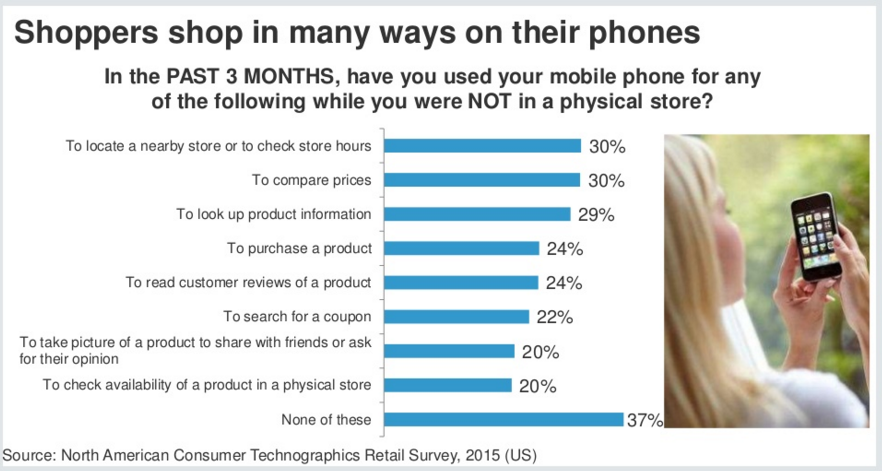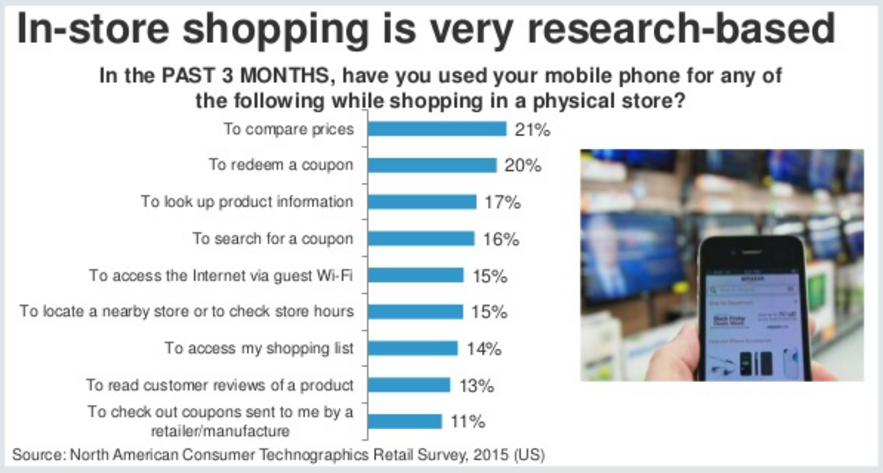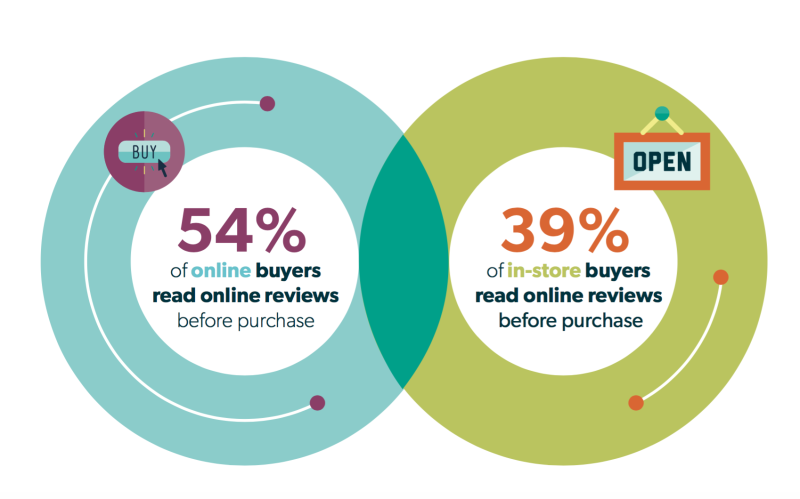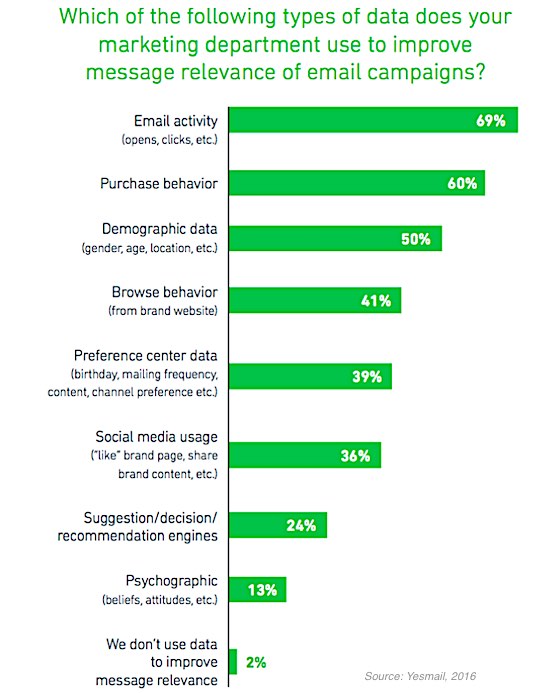Getting Mobile in Retail: Why 87% of Retail Marketers Plan to Up Mobile Spend in 2016
Mobile is taking over retail. Consumers research, price check, compare products, purchase, review products, and contact customer service all from the comfort of their mobile phones. And these uber-connected, mobile shoppers engage with retailers in virtually every way possible – whether they are deciding to purchase from an ecommerce site, researching prior to visiting a brick-and mortar location, and even then, while they are at the physical store location itself. Mobile has swept the retail landscape and retail marketers are flocking to their budgets to get onboard.
Mobile devices are a key aspect of the shopping journey. Here’s a look at how shoppers are using their phones, whether they are in a physical store location or doing research out of the store.
According to the North American Consumer Technologies Retail Survey (2015), the top 5 ways consumers are using their phones while not in a store location include:
- 30% – To locate a nearby store or check store hours
- 30% – To compare prices
- 29% – To look up product information
- 24% – To purchase a product
- 24% – To read customer reviews of a product

While in a physical store, the top 5 ways shoppers used their mobile devices include:
- 21% – To compare prices
- 20% – To redeem a coupon
- 17% – To look up product information
- 16% – To search for a coupon
- 15% – To locate a nearby store or check store hours

In order to meet these rising mobile expectations, a new study by RetailMeNot, Inc. titled “The Rise of Mobile Marketing Spend in Retail,” shows that 87% of retail marketers plan to invest more in mobile marketing in 2016.
According to the report, “Investments in mobile features, such as product reviews on mobile websites and apps, mobile-optimized emails and the ability to download coupons on smartphones will remain steady. However, as retailers expand their mobile efforts and look for new ways to utilize their brick-and-mortar locations, tactics like online fulfillment and buy online pickup in-store (BOPIS) will grow in utilization. Many consumers view their smartphone as a research tool, and visibility to store inventory or location-based deals and more may provide the incentive needed to drive them inside stores.”

Optimize Product Review for Mobile Sites
Product reviews, especially those optimized for mobile websites and apps, continue to dominate digital spend and for good reason. A study by Yes Lifecycle Marketing found that 51% of retailers state differentiating their brand and experiences against competitors to be their biggest challenge (second only to “Identifying and engaging our most valuable customers” at 52%). For today’s informed consumer, who conducts their own research before making a purchase, reviews are often the tipping point of making a decision in cases where there’s little perceived product differentiation.
Dimensional Research found that 90% of respondents who recall reading online reviews were influenced by the reviews in their buying decision; conversely 86% were deterred by negative online reviews. And the practice of checking reviews before making a purchase is becoming more and more common. A recent study by Bazaarvoice found that 54% of e-commerce shoppers read reviews before making a purchase, and 39% of in-store consumers still check reviews online before making their decision. Even more substantial is that the study found that for every $1 that’s influenced by an online review, the impact is multiplied 4-5x’s for instore revenue (read more about the findings here). Ensuring that product reviews are front and center and mobile-optimized is a must with today’s shoppers – both mobile and non-mobile consumers alike.

Source: Bazaarvoice “The ROBO Economy”
Mobile Email Leads the Way for Retail
Email continues to remain one of the most effective channels to drive conversions. And with most consumers now opening emails on mobile devices, this channel must be mobile optimized in order to stand out in a crowded inbox. According to Movable Ink’s US Consumer Device Preference Report, “While 49% of non-apparel retail customers convert on mobile devices – a higher percentage than most industries – retail apparel shoppers show a significantly higher number of mobile conversions. With 67% of conversions happening on mobile devices in Q3 of 2015, it’s the only consumer group that prefers spending money on mobile over desktop.”
Emails must be relevant and personal to drive conversions. 80% of consumers find product recommendations based on previous purchases useful according to eMarketer, and 78% of retail consumers are more likely to become a repeat customer if sent targeted personal offers according to Infosys. Additionally, emails that employ personalization get 29% higher open rates and 41% higher unique click rates than non-personalized emails (Experian Source)
Data is the key ingredient to email personalization, both your internal first party data and data from third-party sources. Internal data may include name, location, birthdate, and product interests. While this information is extremely valuable, today’s consumers expect deeper levels of personalization than ever before. Third party sources can provide additional insights to drive deeper engagement. Popular demographics to consider include home ownership, occupation, estimated income, age, ethnicity, credit card, language spoken, hobbies, purchase behavior, channel affinity, lifestyle interests, presence of children, or hundreds of other demographics that may add value when marketing your particular product.
Overall, according to a recent report by Yesmail, 60% of retail marketers are using purchase behavior data to send more relevant emails, and 50% of those surveyed use demographics data such as age, gender, and location.
The most popular types of data used to increase email campaign effectiveness include:
- 69% – Email activity such as opens and clicks
- 60% – Purchase behavior
- 50% – demographic data
- 41% – browsing behavior from the retailer’s website

Other effective mobile strategies in which retailers are investing more heavily include loyalty programs, mobile coupons and push notifications and alerts. Farther down on the list is location-based marketing, such as beacons and geo-fences. Currently only 1 in 3 retailers partner with beacon experts for their mobile marketing efforts. However, location –based technologies offer retailers the ability to drive more consumers into their brick-and-mortar locations as well as use consumer’s mobile moments in more effective ways.
This is not just the age of mobile, it’s the age of the consumer. Retailers must follow suite to reach consumers with the right message and across the right channels. And in 2016 shoppers are accessing these channels by mobile at every opportunity.
To learn more about reaching the right consumer across channels, download our Right Time Marketing Data Solutions Guide.



